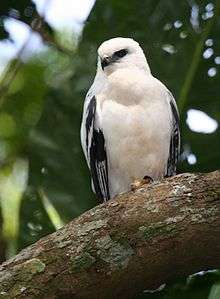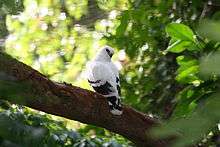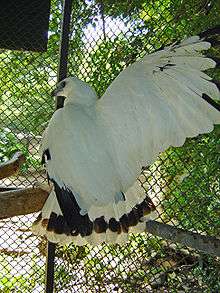White hawk
| White hawk | |
|---|---|
 | |
| Scientific classification | |
| Kingdom: | Animalia |
| Phylum: | Chordata |
| Class: | Aves |
| Subclass: | Neornithes |
| Infraclass: | Neognathae |
| Superorder: | Neoaves |
| Order: | Accipitriformes |
| Family: | Accipitridae |
| Subfamily: | Buteoninae (but see text) |
| Genus: | Pseudastur |
| Species: | P. albicollis |
| Binomial name | |
| Pseudastur albicollis (Latham, 1790) | |
| Synonyms | |
|
Leucopternis albicollis | |
The white hawk (Pseudastur albicollis), a bird of prey breeding in the tropical New World, belongs to the family Accipitridae. Though it is commonly placed in the subfamily Buteoninae, the validity of this group is doubtful and currently under review.
Description


The adult white hawk ranges from 46–56 cm long with very broad wings and has a white head, body and underwings. The upper wings are black, and the very short tail is black with a broad white band. The bill is black and the legs are yellow.
The sexes are similar, but females are larger and heavier (840 g compared to the male's 650 g). Immature birds have extensive black spotting on the upperparts and dark-streaked whitish underparts.
The call of the white hawk is a plaintive kerwee.
Subspecies
There are four subspecies:
- Entirely white, except for black markings on the outer primaries, and a black sub-terminal tail bar. The eyes are yellow.
- Similar to ghiesbreghti but with more distinct black markings on the wings and tail. The eyes are brown.
- Wing feathers are more heavily marked with black, and it has black streaks on the crown and collar. The tail band is broader and the eyes are brown.
- Pseudastur albicollis albicollis – Northern Colombia and central Venezuela to Brazil.
- Smaller than the northern forms and the wings are mostly black, with white markings. The black tail band extends to the base of the tail and the eyes are brown.
All subspecies look mainly white from below. The identity of the birds discovered in 2000/2001 in the Serranía de las Quinchas of central Colombia [2] is unclear.
Distribution and ecology
This is a bird of lowland forest and other woodlands. It ranges from southern Mexico through Central and South America to Peru, Bolivia and Brazil. It also breeds on Trinidad. The white hawk's range in central South America is the entire Amazon basin, from the Andes on the west to the Guianas on the Atlantic on the northeast, and to the transition lands to the south. A widespread species, it is usually not common, but the IUCN considers it not to be globally threatened due to the large extent of its range.[1]
The white hawk feeds mainly on reptiles with some insects and mammals, caught in a sortie from a perch. It associates with foraging groups of tufted capuchin monkeys (Cebus apella) and South American coatis (Nasua nasua) to snatch prey startled by these animals.[3] This species is often seen soaring, and has a spectacular aerial courtship display.
It builds a large stick platform nest in a tree[4] and usually lays one dark-blotched blue-white egg. An attended nest was observed in Ecuador in mid-August.[5]
Footnotes
- 1 2 BirdLife International (2012). "Leucopternis albicollis". IUCN Red List of Threatened Species. Version 2012.1. International Union for Conservation of Nature. Retrieved 16 July 2012.
- ↑ Laverde-R. et al. (2005)
- ↑ de Mello Beisiegel (2007)
- ↑ E.g. Ceiba sp.: Cisneros-Heredia (2006)
- ↑ Cisneros-Heredia (2006)
References
- Cisneros-Heredia, Diego F. (2006): Notes on breeding, behaviour and distribution of some birds in Ecuador. Bull. B.O.C. 126(2): 153-164. PDF fulltext
- de Mello Beisiegel, Beatriz (2007): Foraging Association between Coatis (Nasua nasua) and Birds of the Atlantic Forest, Brazil. Biotropica 39(2): 283–285. doi:10.1111/j.1744-7429.2006.00255.x (HTML abstract)
- ffrench, Richard; O'Neill, John Patton & Eckelberry, Don R. (1991): A guide to the birds of Trinidad and Tobago (2nd edition). Comstock Publishing, Ithaca, N.Y.. ISBN 0-8014-9792-2
- Hilty, Steven L. (2003): Birds of Venezuela. Christopher Helm, London. ISBN 0-7136-6418-5
- Laverde-R., Oscar; Stiles, F. Gary & Múnera-R., Claudia (2005): Nuevos registros e inventario de la avifauna de la Serranía de las Quinchas, un área importante para la conservación de las aves (AICA) en Colombia [New records and updated inventory of the avifauna of the Serranía de las Quinchas, an important bird area (IBA) in Colombia]. Caldasia 27(2): 247-265 [Spanish with English abstract]. PDF fulltext
External links
| Wikimedia Commons has media related to Leucopternis albicollis. |
- Hawk Conservancy Trust
- White hawk photo; Article
- Photo-High Res; Article smithsonian, national museum of natural history
- Stamps (for Belize, Honduras) Stamp-photo
- White hawk photo gallery VIREO
- White hawk videos on the Internet Bird Collection
